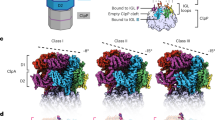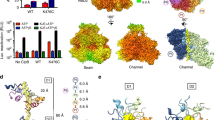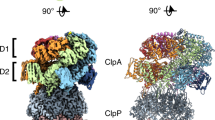Abstract
Energy-dependent proteases often rely on adaptor proteins to modulate substrate recognition. The SspB adaptor binds peptide sequences in the stress-response regulator RseA and in ssrA-tagged proteins and delivers these molecules to the AAA+ ClpXP protease for degradation. The structure of SspB bound to an ssrA peptide is known. Here, we report the crystal structure of a complex between SspB and its recognition peptide in RseA. Notably, the RseA sequence is positioned in the peptide-binding groove of SspB in a direction opposite to the ssrA peptide, the two peptides share only one common interaction with the adaptor, and the RseA interaction site is substantially larger than the overlapping ssrA site. This marked diversity in SspB recognition of different target proteins indicates that it is capable of highly flexible and dynamic substrate delivery.
This is a preview of subscription content, access via your institution
Access options
Subscribe to this journal
Receive 12 print issues and online access
$189.00 per year
only $15.75 per issue
Buy this article
- Purchase on Springer Link
- Instant access to full article PDF
Prices may be subject to local taxes which are calculated during checkout




Similar content being viewed by others
References
Gottesman, S., Roche, E., Zhou, Y. & Sauer, R.T. The ClpXP and ClpAP proteases degrade proteins with carboxy-terminal peptide tails added by the SsrA-tagging system. Genes Dev. 12, 1338–1347 (1998).
Wang, L., Elliott, M. & Elliott, T. Conditional stability of the HemA protein (glutamyl-tRNA reductase) regulates heme biosynthesis in Salmonella typhimurium. J. Bacteriol. 181, 1211–1219 (1999).
Maurizi, M.R. & Rasulova, F. Degradation of L-glutamate dehydrogenase from Escherichia coli: allosteric regulation of enzyme stability. Arch. Biochem. Biophys. 397, 206–216 (2002).
Flynn, J.M., Neher, S.B., Kim, Y.I., Sauer, R.T. & Baker, T.A. Proteomic discovery of cellular substrates of the ClpXP protease reveals five classes of ClpX-recognition signals. Mol. Cell 11, 671–683 (2003).
Gottesman, S. Proteolysis in bacterial regulatory circuits. Annu. Rev. Cell. Dev. Biol. 19, 565–587 (2003).
Flynn, J.M., Levchenko, I., Sauer, R.T. & Baker, T.A. Modulating substrate choice: the SspB adaptor delivers a regulator of the extracytoplasmic-stress response to the AAA+ protease ClpXP for degradation. Genes Dev. 18, 2292–2301 (2004).
Levchenko, I., Smith, C.K., Walsh, N.P., Sauer, R.T. & Baker, T.A. PDZ-like domains mediate binding specificity in the Clp/Hsp100 family of chaperones and protease regulatory subunits. Cell 91, 939–947 (1997).
Gonciarz-Swiatek, M. et al. Recognition, targeting, and hydrolysis of the lambda O replication protein by the ClpP/ClpX protease. J. Biol. Chem. 274, 13999–14005 (1999).
Dougan, D.A., Mogk, A., Zeth, K., Turgay, K. & Bukau, B. AAA+ proteins and substrate recognition, it all depends on their partner in crime. FEBS Lett. 529, 6–10 (2002).
Maurizi, M.R. et al. Sequence and structure of Clp P, the proteolytic component of the ATP-dependent Clp protease of Escherichia coli. J. Biol. Chem. 265, 12536–12545 (1990).
Wojtkowiak, D., Georgopoulos, C. & Zylicz, M. Isolation and characterization of ClpX, a new ATP-dependent specificity component of the Clp protease of Escherichia coli. J. Biol. Chem. 268, 22609–22617 (1993).
Wang, J., Hartling, J.A. & Flanagan, J.M. The structure of ClpP at 2.3 Å resolution suggests a model for ATP-dependent proteolysis. Cell 91, 447–456 (1997).
Kim, D.Y. & Kim, K.K. Crystal structure of ClpX molecular chaperone from Helicobacter pylori. J. Biol. Chem. 278, 50664–50670 (2003).
Maurizi, M.R., Thompson, M.W., Singh, S.K. & Kim, S.H. Endopeptidase Clp: ATP-dependent Clp protease from Escherichia coli. Methods Enzymol. 244, 314–331 (1994).
Weber-Ban, E.U., Reid, B.G., Miranker, A.D. & Horwich, A.L. Global unfolding of a substrate protein by the Hsp100 chaperone ClpA. Nature 401, 90–93 (1999).
Kim, Y.I., Burton, R.E., Burton, B.M., Sauer, R.T. & Baker, T.A. Dynamics of substrate denaturation and translocation by the ClpXP degradation machine. Mol. Cell 5, 639–648 (2000).
Kenniston, J.A., Baker, T.A., Fernandez, J.M. & Sauer, R.T. Linkage between ATP consumption and mechanical unfolding during the protein processing reactions of an AAA+ degradation machine. Cell 114, 511–520 (2003).
Levchenko, I., Seidel, M., Sauer, R.T. & Baker, T.A. A specificity-enhancing factor for the ClpXP degradation machine. Science 289, 2354–2356 (2000).
Keiler, K.C., Waller, P.R. & Sauer, R.T. Role of a peptide tagging system in degradation of proteins synthesized from damaged messenger RNA. Science 271, 990–993 (1996).
Wah, D.A., Levchenko, I., Baker, T.A. & Sauer, R.T. Characterization of a specificity factor for an AAA+ ATPase: assembly of SspB dimers with ssrA-tagged proteins and the ClpX hexamer. Chem. Biol. 9, 1237–1245 (2002).
Wah, D.A. et al. Flexible linkers leash the substrate binding domain of SspB to a peptide module that stabilizes delivery complexes with the AAA+ ClpXP protease. Mol. Cell 12, 355–363 (2003).
Bolon, D.N., Wah, D.A., Hersch, G.L., Baker, T.A. & Sauer, R.T. Bivalent tethering of SspB to ClpXP is required for efficient substrate delivery: a protein-design study. Mol. Cell 13, 443–449 (2004).
Levchenko, I., Grant, R.A., Wah, D.A., Sauer, R.T. & Baker, T.A. Structure of a delivery protein for an AAA+ protease in complex with a peptide degradation tag. Mol. Cell 12, 365–372 (2003).
Song, H.K. & Eck, M.J. Structural basis of degradation signal recognition by SspB, a specificity-enhancing factor for the ClpXP proteolytic machine. Mol. Cell 12, 75–86 (2003).
Flynn, J.M. et al. Overlapping recognition determinants within the ssrA degradation tag allow modulation of proteolysis. Proc. Natl. Acad. Sci. USA 98, 10584–10589 (2001).
Bolon, D.N., Grant, R.A., Baker, T.A. & Sauer, R.T. Nucleotide-dependent substrate handoff from the SspB adaptor to the AAA+ ClpXP protease. Mol. Cell 16, 343–350 (2004).
De Las Penas, A., Connolly, L. & Gross, C.A. The σE-mediated response to extracytoplasmic stress in Escherichia coli is transduced by RseA and RseB, two negative regulators of σE. Mol. Microbiol. 24, 373–385 (1997).
Missiakas, D., Mayer, M.P., Lemaire, M., Georgopoulos, C. & Raina, S. Modulation of the Escherichia coli σE (RpoE) heat-shock transcription-factor activity by the RseA, RseB and RseC proteins. Mol. Microbiol. 24, 355–371 (1997).
Dartigalongue, C., Missiakas, D. & Raina, S. Characterization of the Escherichia coli σE regulon. J. Biol. Chem. 276, 20866–20875 (2001).
Rezuchova, B., Miticka, H., Homerova, D., Roberts, M. & Kormanec, J. New members of the Escherichia coli σE regulon identified by a two-plasmid system. FEMS Microbiol. Lett. 225, 1–7 (2003).
Alba, B.M., Zhong, H.J., Pelayo, J.C. & Gross, C.A. degS (hhoB) is an essential Escherichia coli gene whose indispensable function is to provide σ(E) activity. Mol. Microbiol. 40, 1323–1333 (2001).
Alba, B.M., Leeds, J.A., Onufryk, C., Lu, C.Z. & Gross, C.A. DegS and YaeL participate sequentially in the cleavage of RseA to activate the σ(E)-dependent extracytoplasmic stress response. Genes Dev. 16, 2156–2168 (2002).
Kanehara, K., Ito, K. & Akiyama, Y. YaeL (EcfE) activates the σ(E) pathway of stress response through a site-2 cleavage of anti-σ(E), RseA. Genes Dev. 16, 2147–2155 (2002).
Campbell, E.A. et al. Crystal structure of Escherichia coli σE with the cytoplasmic domain of its anti-σ RseA. Mol. Cell 11, 1067–1078 (2003).
Hersch, G.L., Baker, T.A. & Sauer, R.T. SspB delivery of substrates for ClpXP proteolysis probed by the design of improved degradation tags. Proc. Natl. Acad. Sci. USA 101, 12136–12141 (2004).
Feng, S., Chen, J.K., Yu, H., Simon, J.A. & Schreiber, S.L. Two binding orientations for peptides to the Src SH3 domain: development of a general model for SH3-ligand interactions. Science 266, 1241–1247 (1994).
Yu, H. et al. Structural basis for the binding of proline-rich peptides to SH3 domains. Cell 76, 933–945 (1994).
Collaborative Computational Project, Number 4. The CCP4 suite: programs for protein crystallography. Acta Crystallogr. D 50, 760–763 (1994).
Wallace, A.C., Laskowski, R.A. & Thornton, J.M. LIGPLOT: a program to generate schematic diagrams of protein-ligand interactions. Protein Eng. 8, 127–134 (1995).
Sauer et al. Sculpting the proteome with AAA(+) proteases and disassembly machines. Cell 119, 9–18 (2004).
Acknowledgements
T.A.B., I.L. and J.M.F. are employees of Howard Hughes Medical Institute (HHMI). We thank D. Bolon for the gift the SspB A74Q mutant, G. Hersch for the labeled ssrA peptide and other members of the Baker and Sauer labs for help and advice. This work was supported by HHMI and US National Institutes of Health (NIH) grant AI-16892. Studies conducted at the NE-CAT beamlines of the Advanced Photon Source were supported by award RR-15301 from the NIH National Center for Research Resources and by the US Department of Energy Office of Basic Energy Sciences under contract W-31-109-ENG-38.
Author information
Authors and Affiliations
Corresponding author
Ethics declarations
Competing interests
The authors declare no competing financial interests.
Supplementary information
Supplementary Fig. 1
Electron density and refined model at contact positions between the RseA peptide and SspB that have been probed by mutation. (PDF 2496 kb)
Rights and permissions
About this article
Cite this article
Levchenko, I., Grant, R., Flynn, J. et al. Versatile modes of peptide recognition by the AAA+ adaptor protein SspB. Nat Struct Mol Biol 12, 520–525 (2005). https://doi.org/10.1038/nsmb934
Received:
Accepted:
Published:
Issue Date:
DOI: https://doi.org/10.1038/nsmb934
This article is cited by
-
Functional cooperativity between the trigger factor chaperone and the ClpXP proteolytic complex
Nature Communications (2021)
-
Defining the geometry of the two-component proteasome degron
Nature Chemical Biology (2011)
-
Structural basis for the unfolding of anthrax lethal factor by protective antigen oligomers
Nature Structural & Molecular Biology (2010)
-
Adapting the machine: adaptor proteins for Hsp100/Clp and AAA+ proteases
Nature Reviews Microbiology (2009)
-
How to pick a protein and pull at it
Nature Structural & Molecular Biology (2008)



